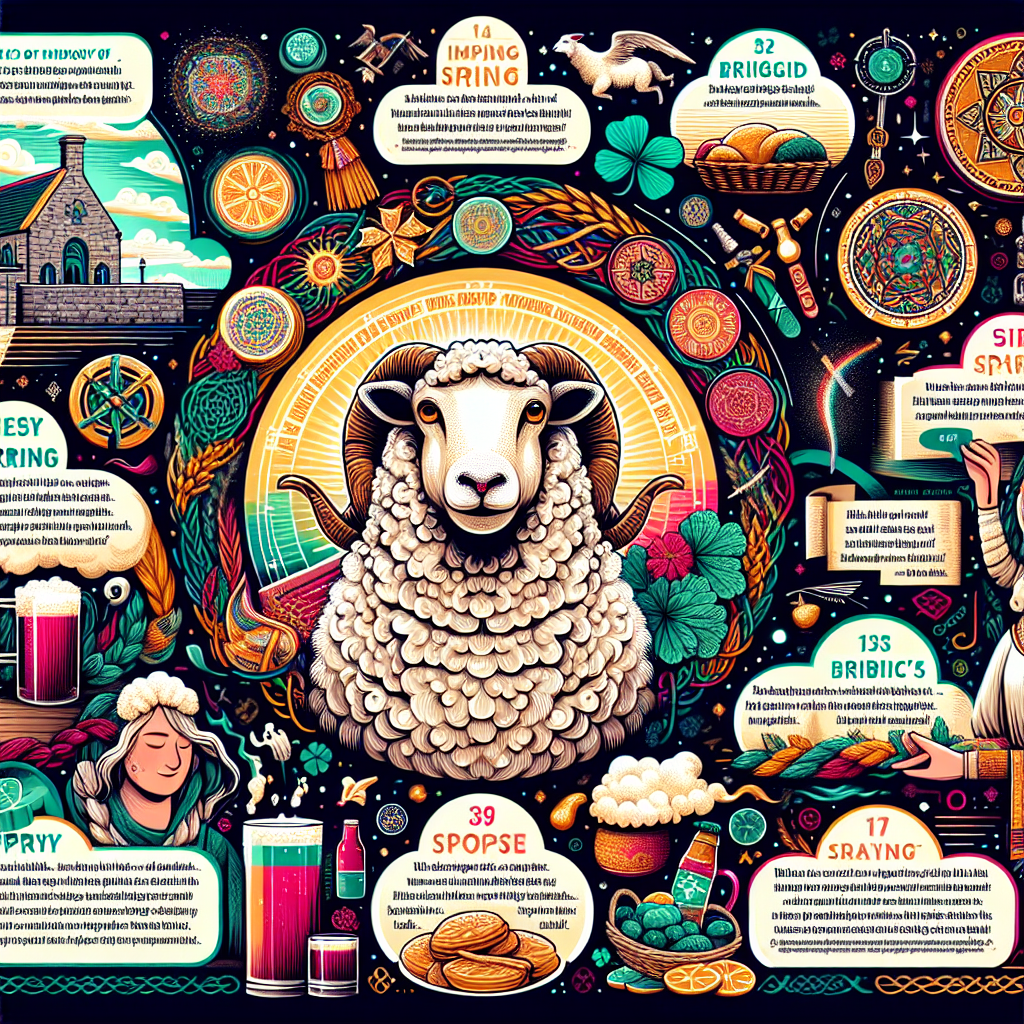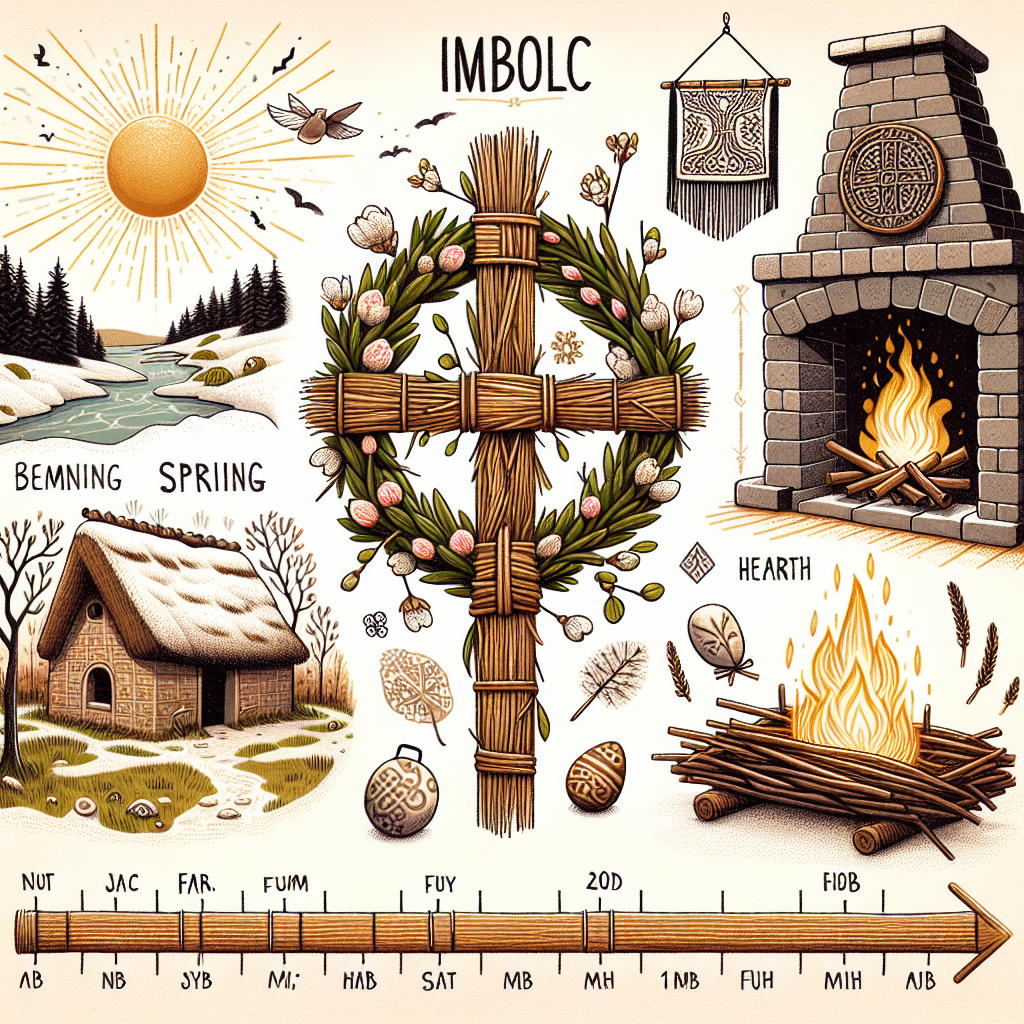As an Amazon Associate I earn from qualifying purchases.
↻
Last updated: December 24, 2025

Imbolc is a traditional Gaelic festival marking the beginning of spring, celebrated on the 1st or 2nd of February. This time-honored celebration heralds the stirring life beneath the winter's blanket and the rebirth of the natural world. Originally, it was observed in Ireland, Scotland, and the Isle of Man, and it's closely associated with the goddess Brigid, who, in the pagan tradition, is a figure of fertility and the personification of the season's new growth.
The word “Imbolc” derives from Old Irish meaning “in the belly,” which alludes to the pregnancy of ewes, a sign of the impending lambing season and a reminder that life continues even in the coldest months. Central to the festival is the reverence of Brigid, later Christianized as Saint Brigid, a patroness of poetry, smithing, medicine, and livestock. On the eve of Imbolc, it was customary to leave out a piece of cloth or ribbon for Brigid to bless as she visited, imbuing it with protective and healing properties.
Festivities of Imbolc comprise various customs that highlight the transition from winter to spring. One of the prominent features is the lighting of candles and fires, symbolizing the return of warmth and the increasing power of the sun over the coming months. Communities would engage in special feasts, the lighting of bonfires, Brigid cross crafting, and visits to holy wells, where it was customary to pray for health while walking ‘sunwise' around the well.
In modern times, Imbolc is part of the neopagan Wheel of the Year and is one of the eight Sabbats—festivals celebrated by Wiccans and other neopagans. It's a time of purification and renewal, often observed with rites and rituals that include the making of Brigid's bed—a small bed crafted for Brigid's doll, which is thought to ensure fertility and good fortune.
Beyond the spiritual and historical aspects, Imbolc has practical agrarian roots. Not only does it highlight the importance of sheep in Celtic societies, especially due to their wool and milk, but the timing of Imbolc also coincides with the birthing and nursing of lambs. This season remains a critical period for farmers, as it denotes the preparations that need to be made for the spring's work.
Among the surviving Imbolc traditions is the divination of weather patterns; folklore suggests that serpents or badgers emerging from their dens at Imbolc signify the length of the remaining winter. This belief parallels the North American tradition of Groundhog Day, celebrated on the 2nd of February, which determines the advent of spring based on the groundhog's shadow sighting.
As an enduring hallmark of the transition from darkness to light, Imbolc carries a powerful symbolism that resonates with many seeking to celebrate the cyclical nature of the environment. It's not just a link to the past but also a ritual of cleansing and preparation. Many people still practice the custom of spring cleaning, which is spiritually aligned with the essence of Imbolc, representing the sweeping away of the old and welcoming the new.
While it's difficult to quantify the impact or popularity of ancient festivals in contemporary times, the enduring celebration of Imbolc speaks to a universal human recognition of the changing seasons and reflects a yearning for the warmth and fertility that spring promises. Whether through cultural festivals, religious observances, or personal reflection, the themes of Imbolc continue to inspire those who mark the occasion.
html
What are 8 Fascinating Festive Facts about Imbolc, the Ewe and Goddess Celebration?
Imbolc is an ancient Celtic festival marking the beginning of spring and celebrating the Goddess Brigid, known for her association with healing, poetry, and smithcraft. Traditionally observed on February 1st, this festival also honors the lactating sheep, as ‘Imbolc' translates to ‘in the belly,' alluding to pregnancy in ewes. Its significance lies in the anticipation of new life and fertility as nature awakens from the cold embrace of winter. The customs involve lighting fires, crafting Brigid's crosses, and preparing traditional foods, all of which symbolize the revitalization of the earth and the warm embrace of longer days ahead. As we delve deeper in the following sections, get ready to explore the historical origins, symbolic practices, and the continued relevance of Imbolc in modern celebrations that weave together ancient lore and contemporary spirituality.
Imbolc is an ancient festival rooted in Celtic tradition, marking the beginning of spring and the halfway point between the winter solstice and the spring equinox. Here are eight festive facts about Imbolc that highlight its transformation from goddess worship to agrarian celebrations:
1. **Origins in Goddess Worship:**
Imbolc, also known as Imbolg or Oimelc, originates from the pagan festival celebrating the Celtic goddess Brigid, the goddess of fire, healing, and fertility. The festival marked the end of winter and the return of light and fertility to the land.
2. **Brigid's Many Aspects:**
The goddess Brigid was a multifaceted deity associated with poetry, smithcraft, and midwifery, in addition to her traits mentioned before. Her diverse attributes are reflected in the varied customs of Imbolc, which celebrate creativity, home, and the promise of renewal.
3. **Christianization of Imbolc:**
With the spread of Christianity, Imbolc was repurposed as Saint Brigid's Day around the 5th century, blending pagan traditions with Christian beliefs. Saint Brigid of Kildare shares many characteristics with the goddess Brigid, illustrating the syncretism of the two figures.
4. **The Cailleach Connection:**
Imbolc was also associated with the Cailleach, the divine hag of Gaelic tradition. Legend says if she wishes to prolong the winter, she makes the day sunny and bright, so she can gather plenty of firewood. If the weather is foul, it means the Cailleach is asleep and winter is almost over.
5. **Symbolism of Fire:**
Fire plays a central role in Imbolc celebrations, representing the return of the sun's warmth. Bonfires are lit, and candles are burned to symbolize the increasing power of the sun over the coming months.
6. **Spring Cleaning:**
The festival is traditionally a time for cleaning and purification after the long winter, symbolizing a fresh start. Homes are thoroughly cleaned, and old items may be discarded or donated, signifying the clearing away of the old to make way for new growth.
7. **Agricultural Significance:**
Imbolc signifies the beginning of the lambing season when ewes give birth to the first lambs of the year. Hence, this festival is deeply intertwined with agrarian rhythms, celebrating the renewal of life and the fertility of the animals that sustain farming communities.
8. **Modern Celebrations and Crafts:**
Today, people continue to observe Imbolc, both in traditional and contemporary ways. Modern pagans and those interested in Celtic spirituality may create Brigid's crosses from reeds or straw to hang in their homes for protection, make Brigid dolls, and hold feasts.
A statistical tie to Imbolc is not easy to find due to the nature of the festival—however, the continued popularity of the festival could be seen in its widespread observance. One particular figure that stands out is the annual Brigid's Day festival in Kildare, Ireland, which draws attendees from around the world, showing the enduring legacy of the festival's namesake and the ongoing cultural significance of Imbolc in the 21st century.
html
1. What is Imbolc and when is it celebrated?
Imbolc is a traditional Gaelic festival marking the beginning of spring, typically celebrated on February 1st or 2nd. It is one of the four Celtic seasonal festivals, along with Beltane, Lughnasadh, and Samhain.
2. What does the term “Imbolc” mean?
The term “Imbolc” is derived from Old Irish and means “in the belly,” referring to the pregnancy of ewes. It is a time that signals the upcoming birth of spring and new life.
3. Who is the goddess associated with Imbolc?
The goddess often associated with Imbolc is Brigid (or Brighid), who is a Celtic goddess of healing, poetry, and smithwork. She symbolizes the light and power of the sun, which brings about renewal.
4. How is Imbolc traditionally celebrated?
Imbolc was traditionally celebrated by lighting fires, visiting holy wells, and performing rituals to invoke the goddess Brigid for protection. Homes would be adorned with Brigid's crosses and a doll-like figure of Brigid, known as a ‘Brideog,' would be created.
5. What modern celebrations are associated with Imbolc?
Modern Imbolc celebrations can include candlelit processions, crafting Brigid's crosses, feasts of seasonal food, poetry readings, and the lighting of candles or fires to symbolize the return of warmth and light.
6. What are some symbols and customs of Imbolc?
Symbols and customs include the lighting of candles, Brigid's cross (a woven cross made from rushes or reeds), the Brideog, and the practice of leaving out a cloth or scarf overnight for Brigid to bless as she is said to visit homes on Imbolc eve.
7. Can Imbolc be celebrated by those not of Celtic heritage?
Yes, Imbolc can be celebrated by anyone interested in acknowledging the change of seasons, ancient customs, or the themes of purification, light, and renewal that the festival embodies.
8. Is Imbolc related to Groundhog Day?
Imbolc is related to Groundhog Day in that both occur at the beginning of February and involve traditions of predicting the coming of spring. Groundhog Day is believed to have been derived from ancient traditions similar to those of Imbolc celebrations.
9. Are there any specific foods associated with Imbolc?
Imbolc is associated with dairy products because it coincides with the beginning of lactation in ewes. Traditional foods might include dishes made with butter, milk, and cheese, as well as seeds, representing potential growth.
10. How can I make a Brigid's cross?
To make a Brigid's cross, you will need rushes or reeds and some string or ribbon. The process involves folding the reeds in a specific pattern to create a cross with four arms of equal length and a woven square in the center. Instructional guides and videos can help with the specific steps involved.

Conclusion
Imbolc's roots as a festivity take us back to ancient Pagan traditions, honoring the goddess Brigid who embodied the promise of spring's return. This transition from cold to renewal is mirrored in the core festivities of Imbolc which include the lighting of candles and fires, signifying the rebirth of sunlight as well as spiritual enlightenment. These customs have been adapted through time, merging with Christian traditions to celebrate St. Brigid's Day, thus illustrating the evolution of cultural practices from pagan to modern religious observance.
The festival's connection to agriculture is equally profound, symbolized by the ewe, a representative of the cycle of life and the forthcoming abundance. Imbolc heralds the lambing season, a reminder of new beginnings and the fertility of the land. Beyond its historical and pastoral significance, the festivity encourages the purification and preparation of oneself for the coming spring. It serves as a time for reflection, decluttering, and nurturing creative ventures, embodying a holistic approach to the transition between seasons. The rich tapestry of Imbolc's traditions and symbols—spanning from the divine to the agrarian—continues to resonate, fostering a connection with nature's rhythms and human heritage.
Amazon and the Amazon logo are trademarks of Amazon.com, Inc, or its affiliates.
Continue Your Magical Journey
Free Witchcraft Starter Kit
Get 6 free printable PDFs: grimoire pages, moon calendar, spells, crystals, herbs, and tarot journal.
We respect your privacy. Unsubscribe anytime.
Enhance Your Practice
As an Amazon Associate, I earn from qualifying purchases.

